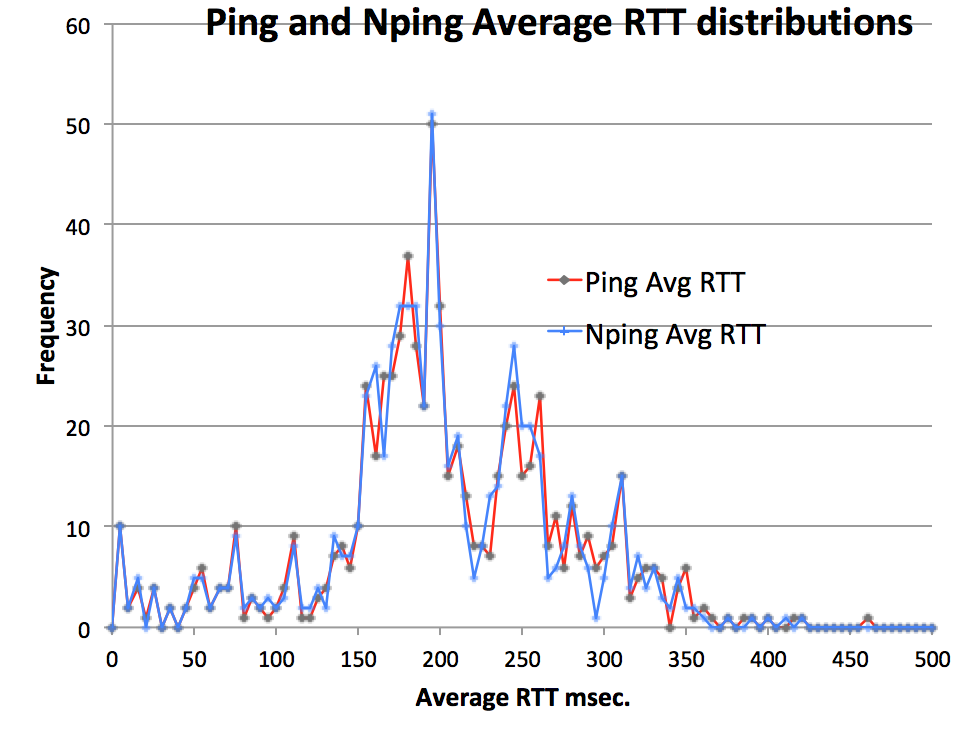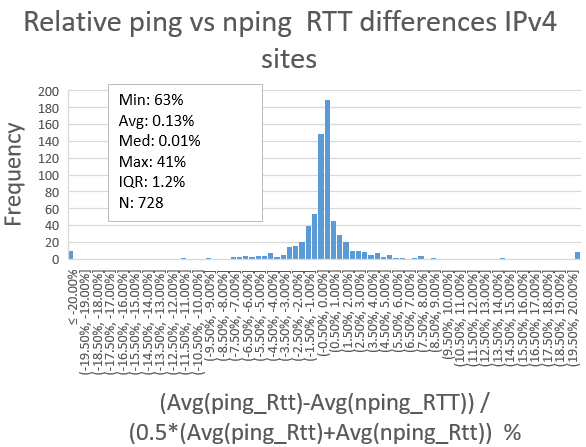Introduction
There are several articles in the literature that warn against using ping/ICMP measurements of RTT compared to TCP and UDP measurements. See for example:
- https://isc.sans.edu/forums/diary/Ping+is+Bad+Sometimes/11335/
- http://www.tomshardware.com/answers/id-3023937/icmp-latency-tcp-latency.html
- https://networkengineering.stackexchange.com/questions/35376/how-to-find-out-tcp-udp-latency-of-your-network
The concerns are that both the ISPs and the end-node sites de-priortitize ICMP compared to TCP and UDP based applications.
In 1998 we compared the round trip times (RTT) and losses measured by ping with those measured between sending the SYN packet for a TCP stream and receiving the ACK back. we found that the distributions agreed well, e.g. the median and average RTTs and losses agreed well (well within the Inter Quartile Range) of the distributions.
Since then there may have been increased de-prioritizing which could increase the differences in the two types of measurements, we decided to re-evaluate the differences.
It would be good to quantitatively understand these differences and understand how they manifest themselves (e.g. region of world for targets, ipv4 and ipv6).
A project to quantitatively compare TCP and ICMP RTTs and losses would be to use hping3 (does not support ipv6) or nping (supports ipv6) to measure TCP RTTs and losses to multiple web servers (port 80) already pinged by PingER and compare them to those of similar ICMP. measurements (made from the same measurement agent (MA) at similar times)
For example we could use the command:
486cottrell@pinger:~$sudo nping -p 80 -c 2 -6 --tcp-connect 2001:da8:270:2018:f816:3eff:fef3:bd3 Starting Nping 0.5.51 ( http://nmap.org/nping ) at 2018-01-13 15:21 PST SENT (0.0021s) Starting TCP Handshake > 2001:da8:270:2018:f816:3eff:fef3:bd3:80 RECV (0.1679s) Handshake with 2001:da8:270:2018:f816:3eff:fef3:bd3:80 completed SENT (1.0041s) Starting TCP Handshake > 2001:da8:270:2018:f816:3eff:fef3:bd3:80 RECV (1.1692s) Handshake with 2001:da8:270:2018:f816:3eff:fef3:bd3:80 completed Max rtt: 165.789ms | Min rtt: 165.073ms | Avg rtt: 165.431ms TCP connection attempts: 2 | Successful connections: 2 | Failed: 0 (0.00%) Tx time: 1.00329s | Tx bytes/s: 159.48 | Tx pkts/s: 1.99 Rx time: 1.16836s | Rx bytes/s: 68.47 | Rx pkts/s: 1.71 Nping done: 1 IP address pinged in 1.17 seconds
Together with this we could use the list of PingER www hosts that respond to pings. Note that sometimes pings are blocked to a host but TCP port 80 packets work, e.g. adl-a-ext1.aarnet.net.au (202.158.195.68).
Project
We wrote a script ping-vs-tcp.pl.
Usage: ping-vs-tcp.pl [opts]
Opts:
-v print this USAGE information
-D debug_level (default=0)
-p protocol (6 or '') (default '')
-a application port (default = 80)
-c count of pinfs to be sent (default = 10)
Function:
Ping the host provided in %NODE_DETAILS
For each host it gets the IP address either from NODE_DETAILS (IPv4)
or using the dig command (IPv6).
It then Pings and npings the host and gathers the min, average, maximum
RTTs and losses and reports them to STDOUT. together with a time stamp
and host information such as name, IP address, country, region etc.
Externals:
Requires nping (requires root/sudo privs), dig
Input:
It gets information on the PingER hosts from %NODE_DETAILS using:
wget to get the required file from http://www-iepm.slac.stanford.edu/pinger/pingerworld/slaconly-nodes.cf. The required file is saved
in in /tmp with a unique name /tmp/nodes-3458.cf (based on the process number).
Examples:
ping-vs-tcp.pl
ping-vs-tcp.pl -p 6 -a 22 -c 10
ping-vs-tcp.pl -v
The output is in comma separated value format and is exported to Excel (one file for IPv4, one for IPv6) where it is analyzed to look at the histograms of Average(ping_rtt)-Average(nping_rtt) etc. The script was run from a host (pinger.slac.stanford.edu) located st SLAC in Northern California in the San Francisco Bay Area. It was run multiple times to ensure the behaviour was not dependent on time of day or day of week etc. For the IPv4 data measurements, the script ran for about 6hours and 45 minutes. The distribution histograms shown below show that the agreement between ping and nping average RTT is good:
IPv4: of the 728 hosts responding to both ping and nping on port 80 (there are about 270 respoinding to port 22), 50% have Average(RTTs) for ping and nping within 2.15ms of one another. The hosts are in 160 different countries with China having the most hosts with 195, followed by the United States with 52, Indonesia with 37, Malaysia with 27 and Pakistan with 13. In terms of regions the top region is East Asia with 206 hosts, 101 from Africa, 63 from Europe and 58 from North America (Canada and the United States). There are 593 host that have 'www' in the name. The range of average ping RTTs is from 0.327ms to 377ms. The range of nping RTTs is from 2.3ms to 387ms.
The Frequency histograms of average ping and average nping RTTS are shown below (Excel spreadsheet is here)It is seen that there is little difference in the two distributions. We thus compare the Cumulative Distribution Frequencies (CDF) by plotting their differences, note this is a step towards using the Kolmogorov–Smirnov (K-S) nonparametric test of the equality of continuous, one-dimensional probability distributions and yields a maximum difference (supremum) of 3.18% at 255 msec. K-S indicates that the probability of rejecting the null hypothesis (the null hypothesis says there is no relationship between the two measured phenomena) is high.
To exemplify the differences in the RTTs measured by ping and nping we show the frequency distribution of the differences in the two Average RTTs. The histogram of the differences in the ping and nping averages RTTs is shown below.
Another way of looking at the data is to consider the relative differences, i.e. (Avg(ping_RTT)-Avg(nping_RTT)/(0.5(Avg(ping_rtt)+Avg(nping_RTT)), this gives the distribution below that shows the IQR of the averge difference is ~ 1.2%. If one looks at the hosts that have relative differences of > 22% or less than -22% (about 2% of the hosts), we find most are from China or have low RTTs (< 4 msec).- IPv6: 50% of the 36 hosts measured have average(RTTs) within 0.26ms of oneanother).
Again the relative ping vs nping differences for IPv6 is shown below and shows an IQR of the relative average difference is 0.45%:






